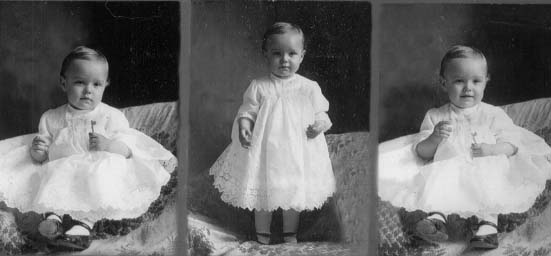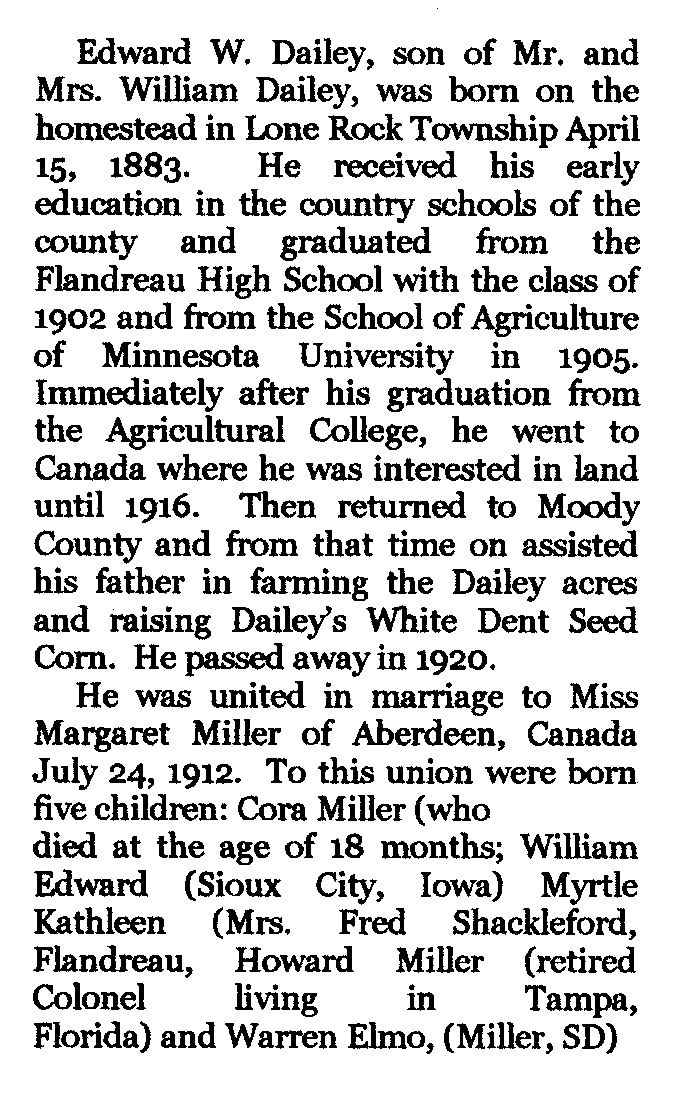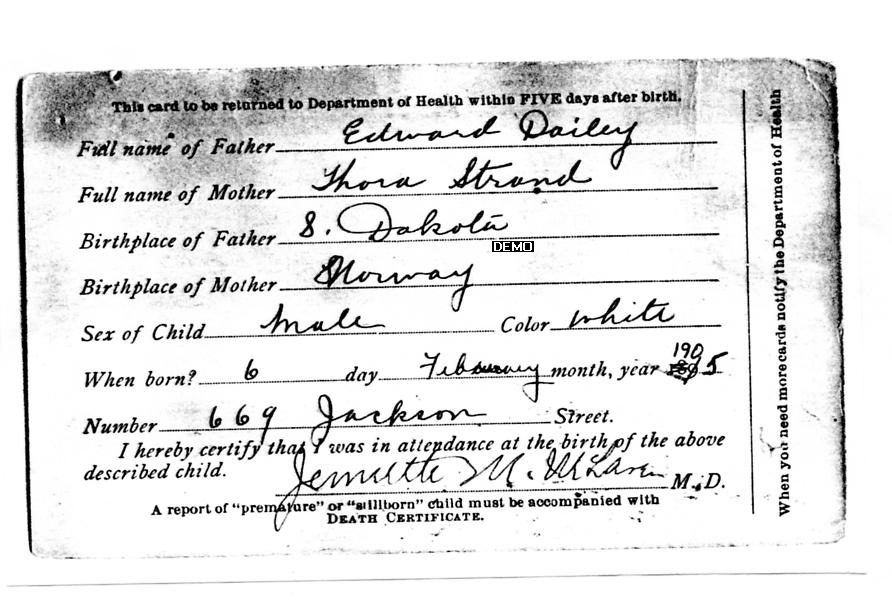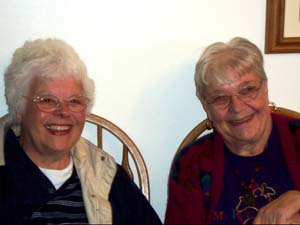
EDWARD W
ILLIAM DAILEY
Edward Dailey was born 15 APR 1883 at Lone Rock Township, Moody, Dakota Territory. He was the son of William (Will) Dailey and Amelia Christiana (Minnie) Mallder` Dailey. He probably lived the life of any other young farm boy of the time.
After graduation from Flandreau High School in 1902 Edward attended Agriculture College at the University of Minnesota at St. Paul, Minnesota. Upon graduation from the Agriculture College Edward moved to Canada, returning to South dakota in 1916 to work with his father. While in Canada Edward married Margaret Miller from Aberdeen, Canada. They had five children.
1. Cora Miller, who died at 18 months.
2. William Edward
3. Myrtle Kathleen
4. Howard Miller
5. Warren Elmo
Edward died in 1920 leaving a widow, Margaret, and four children. The family continued to live on the farm in the old farmhouse. When Minnie died in 1944 Lawrence and Stella inherited that property and the story is that Stella had them evicted. They moved to Flandreau, Moody, SD.
A new genealogy cousin, Ellen Jennings, has come into our lives and done extensive research in order to find out about her grandfather, Karle Reinke. The story takes a turn relevant to the Dailey family when a Norwegian immigrant, Thora Strand, who worked in the Dailey home became pregnant and there is some evidence that Edward William Dailey was the one responsible. Ellen ran the story by some descendants of Will and Minnie Dailey and was given the families enthusiastic blessing to pursue the story. Ellen's research and persistence has been excellent. Let Ellen tell the story in her own words.
This is a story that might never have been told and it will always be missing many key details. It does, however, have a happy ending. It is a story that needs to be told for those who knew and loved Karle Reinke and, more importantly, for those who never had the privilege of meeting or knowing this remarkable yet humble man. This is the story of a man who never knew his biological parents and learned of his adoption from other kids when he was just a child himself. As far as we know, his parents never discussed the fact of his adoption with him and he discovered his adoption papers when cleaning out his father's desk after his death. We'll never know what range of emotions he experienced about being adopted and his parents' secrecy about it except that as an adult, he referred to the Reinkes as "those kind people who took me in."
After several years of genealogical research, and countless letters and emails exchanged with kind and helpful strangers and one sympathetic judge, the basic facts of Karl Albert Reinke's beginnings can be documented. It is a story he never knew and those who did know apparently took it with them to their graves. The birth parents also never knew what became of the life they created since his birth records were sealed and were never meant to be unsealed. The facts are laid out here with very little embellishment and just a bit of speculation. We may wish to know more, but must remember that it is only since Oprah that people feel the need to bare their souls to the world.

Karle grew up in Minnesota among a private people during a more private time than today. This may be as much as we'll ever know about Karle Reinke's beginnings. His legacy, however, continues in the lives of his daughters, grandchildren and countless students. Had they known Karle's story, his biological parents could have been very proud of the man their son became.
Karle's adoption records list Thora Strand as his birth mother and that her baby was born on January 31st, 1905 in St. Paul, Minnesota. His adoption by Otto and Mary Reinke became official on September 20,1906.
Who was Thora Strand? I posted this question on a Strand message board in May of 2001:"According to his adoption papers, my grandfather was born in MN in 1906 and his birth mother was listed as THORA Strand. Does this name ring a bell with anyone?"
This reply from Carol Solheim of Crookston, MN was posted in August of 2001:
"I have a Thora Strand in our ancestry. Born Aug. 28,1880 in Tjøtta Norway.
Lived in MN. Had two daughters, one born in 1911 and the other born in 1913."
Carol is Thora's great niece and the family's genealogist. She also turned out to be incredibly helpful to someone suggesting that her Great Aunt Thora might have had a child out-of-wedlock. Our emails flew back and forth as each piece of the puzzle seemed to fit and we shared common family pictures and traits: lots of educators, some strong family resemblances and even TWIN TOES. (When his first daughter was born with her second and third toes joined to the second joint just like his, Karle cried because she was the first person he knew who was really related to him by blood.)
Thora Danielsen (Tora Berntsdatter) was born on August 28,1880 in Tjøtta, Helgoland, Norway. She was the sixth of eight children born to fisherman (Tisker, Strandsidder) Bernt D. Danielsen and his wife Anna Pettersdatter. By 1900, twenty-year old Tora's occupations were listed in that year's Norwegian census as 'Husgjerning, Kreatursetel, Tjeneste (housekeeping, cattle keeper, servant.) The name of their domicile was Tømmervikstranden and when he became the first of the family to immigrate to the United States, her older brother Andreas R. Berntsen changed his name to Richard Andreas Strand, taking the name of their residence (Strand) in Norway as his surname, not an uncommon naming practice by immigrants of that day.
In May of 1902, Thora's older brother Richard Strand landed at the port of Sault Ste. Marie, Michigan and moved to Crookston, Minnesota where he began working as a carpenter for the Great Northern Railway. He worked there until he retired in 1961. About one year later, in 1903, Richard's 23 year-old wife Karoline, their two young children, his 27 year-old brother Thomas and 23 year-old sister Thora also immigrated to the United States. (I have been unable to document the exact date or their ship or port of arrival. Carol Solheim thinks it might have been in September of 1903.). Thomas joined his brother working on the Great Northern Railway and Karoline moved to Crookston and settled in with her husband and their children at 316 Minnesota Street.
After arriving in America, Thora moved to a large farm at Lone Rock Township, Moody County, South Dakota to work to pay off the cost of coming to the U.S. In the 1905 South Dakota State Census, Thora was enumerated as a 24 year-old single Norwegian-born housekeeper who could read and write. In 1905, Thora was living with and working for the family of Will Dailey, a prominent and well-respected pioneer farmer and stockman in Moody County. The Dailey family was widely known to take in those in need, including children of neighbors who had fallen on hard times. (I do not know how Thora came to live with the Dailey's, especially since the rest of her family lived in northern Minnesota. My guess would be that the Dailey's advertised for domestic help in a newspaper. Flandreau had a large Norwegian population.)
The 1905 South Dakota State Census was recorded on index cards and each card was numbered sequentially, so all those in one household can be identified by their numbers as well as their address.
These were the people listed in the Dailey household at Section 32 Township
106 Range 47 in Lone Rock Township, Moody County, South Dakota in 1905
according the number of their index card:
#171 Will Dailey; 49 year-old farmer, born in Iowa and lived in South Dakota
for 27 years.
#172 Mrs. Will Dailey; 46 year old farmer born in New York (her card was hard
to read)
#173 Robert Dailey; 23 year old farmer, born in South Dakota
#174 Lawrence Dailey; 21 year old farmer; born in South Dakota
#175 Eddie Dailey; 22 year old farmer; born in South Dakota
#176 Tora Strand; 24 year old housekeeper; born in Norway and had been in
U.S. for 2 years
(This is the key piece of evidence putting Thora and Edward under the same roof at the same time, which would have allowed them to at least know each other.)

By 1906, Miss Thora Strand has moved to Minnesota and is listed in the town directory as living at 316 Minnesota Street in Crookston, the home of her brother Richard. By the 1910 census, Thora Strand is living as a domestic servant with the David Miller family in Angus Township in Polk County, Minnesota. Also living with the family as a boarder with no occupation is Thora's brother Thomas, who had been crippled six years earlier in an accident at work in which a rail car had fallen on him. (Thomas died in 1914 at age 38.) Thora married Conrad Johnson in 1910 and they had two daughters. Helen Alvina was born in 1910 and Cora Teresa was born in 1911. Thora died in 1951.

The Dailey family clearly valued higher education. Both Will Dailey and his brother, James, had been educated after their high school graduations in Iowa seminaries and Will went on to become a teacher in Iowa before moving to establish a homestead in South Dakota in 1876. After their graduation from high school, he sent his own sons to the University of Minnesota School of Agriculture before they set out to farm on their own. Edward Dailey graduated in 1905 from the university which was located in St. Paul and moved immediately afterwards to Canada where he lived until 1916 when he moved back to the family farm with his Canadian wife, Margaret Miller and their four children. (One wonders if there was any connection between Thora's pregnancy and Edward's move to Canada. Another question which may never be answered.) Edward died in 1920 of pneumonia at age 37, leaving his widow and four young children.
Those are the facts, but there was another fact, however, that remained unknown for almost 100 years. This fact is that Thora Strand gave birth to a baby boy on Feb. 6, 1905 in St. Paul, Minnesota and on his birth certificate Edward Dailey from South Dakota was listed as the father.

The birth certificate originally had "Illeg" typed on it and that was later crossed out by hand. [Does that mean something? One official at the Children's Home Society said that she believed that the parents of this baby were married. But I have found no evidence of a marriage in South Dakota or Minnesota.] Does his name on the birth certificate prove for absolute fact that Edward was the father of Thora's baby? No. She could have lied or been mistaken. It is, however, quite physically possible, that Edward Dailey and Thora Strand were the parents of this baby boy. But we will probably never know for sure what, if anything, really happened between these two young people. But whatever it was, it wasn't meant to last.
The baby boy was placed about five weeks later, on March 16,1905, at the Children's Home Society in St. Paul, Minnesota where he was recorded as Baby Boy Strand, 111 [illegitimate?] whose mother was Thora Strand, Norwegian and whose unnamed father was English [sic]. (In the CHS's old record book, the baby's date of birth is also different from the birth certificate and is listed as Jan. 31,1905 and the parents' ages seem to be completely wrong, too. In a phone conversation with Janet Jenkins, a current employee of the CHS suggested that Baby Boy Strand was first "placed in May with a family and for a reason which was not noted, he was later replaced with the Reinke family who later adopted him legally." I am left with questions about this first placement since no record of that was given to me.)

On September 20, 1906 Otto and Mary Reinke of Fairfax, Minnesota became the legal parents of Baby Boy Strand and named him Karle Albert Reinke. He would be their only child. Karle was reared in Fairfax amidst a large extended family that enjoyed frequent gatherings and Karle remained connected to them even after he moved away. He enjoyed hunting and other outdoor activities with his father who could be a stem disciplinarian. Otto was a licensed mortician and worked in a furniture store/funeral parlor in Fairfax. In the 1930's he moved to Northwood, Iowa where he owned and managed a variety store with his niece Esther Reinke. Although Karle's mother Mary's health was frail and she was a somewhat nervous woman, she had strong opinions about Karle's actions even after he was married. At one point, Karle had been offered a job as a forest ranger in the far north woods of Minnesota and Mary let him know in no uncertain terms that he should not even consider taking the job and dragging his young wife and babies into the distant and dangerous northern Minnesota wilderness. Dutifully, Karle turned down the job offer. He did find many ways throughout his lifetime to enjoy time in the outdoors as a conservation officer during his summers off from teaching.
Karle grew up in Fairfax, Minnesota and graduated from Fairfax High School in 1922. He went to Hamline University in St. Paul, Minnesota and majored in English. He graduated in 1926 and began his teaching career.
 Karle Reinke and Dorcas Mekkelson upon their engagement
Karle Reinke and Dorcas Mekkelson upon their engagement
He married Dorcas Mekkelson, a fellow student from Hamline University who also became a teacher and they moved to Faribault, Minnesota. He taught biology at Faribault High School for 34 years, reared two daughters and sent them both to excellent colleges. Janet worked as a social worker and as a writer and Gretchen became a teacher.
 The two Reinke sisters, Gretchen Reinke Price and Janet Reinke Jenkins
The two Reinke sisters, Gretchen Reinke Price and Janet Reinke Jenkins
In his summers, Karle found outside jobs, which allowed him to study and help preserve the natural beauty of local and national parks as well as supplement his meager teacher's salary. He was instrumental in establishing Nerstrand Woods, a state park in Rice County, near Faribault. Karle's influence is still being felt in the classrooms of two of his granddaughters who followed in his footsteps and are innovative and well-respected classroom teachers in their own rights.
Dorcas Reinke died in May of 1962 and Karle died of a heart attack in August of 1963. Their daughter Janet always believed that he really died of a broken heart because he just couldn't bear to live his life without his beloved wife.
Memories of Karle Reinke from his daughter, Janet Reinke Jenkins.
(1991)
"I NEVER MET A MAN who couldn�t teach me something," my dad often told us. Karle Reinke was a teacher himself, a biologist, and a great listener.
To avoid taking high school Physics, I enrolled in his Biology class. No question of nepotism - he treated all of his students alike, as if they were his own kids. He loved his subject, but he also had such wide-ranging interests and curiosity, that he was easy to swerve from his lesson plan. We learned more than just Biology in his classroom.
He was graduated from Minnesota�s Hamline University as an English major, and he had dozens of poems in his memory bank, ready to pull up at appropriate times. These ranged from "Casey at the Bat," to some majestic epic, which he recited each year when we first saw the Rocky Mountains as we traveled west over the Great Plains, en route to Glacier Natonal Park.
During much of his career, teaching was a nine-month job, with only nine paychecks. (These were Depression years, with salary decreases as predictable as pay raises are now.) Some years, he picked up additional education: one year at the Okoboji biological field station in Iowa, another at a station near Lake Itasca in Minnesota where we spent the summer in a tent. Most years, though, he worked at a summer job. One year, he shocked and counted fish in southeast Minnesota, another he counted insects in Minnesota�s Red River potato fields, He later traveled western Wisconsin representing a Faribault seed company.
But his favorite and final summer jobs were in Glacier, in the Rocky Mountains of western Montana. Most years, he was a ranger naturalist, leading hikes, giving lectures and slide presentations, and manning information stations. Sister Gretch and I often rode to Logan Pass in the back of his Park pickup, with a spectacular view of the looming mountains. (Much like the view I later had from the back seat on The Mister�s GoldWing motorcycle.)
During World War II, when Glacier was shut down, he worked there as a fire guard, patrolling trails and fire roads.
Daddy was an avid sportsman, and loved to hunt. I grew up eating venison, duck, squirrel, rabbit and pheasant. I was nearly grown when I realized "beautiful mallard" was two separate words; I�d never heard "mallard" solo.
He also was a fly fisherman. Summers, he�d go fishing at dawn in the beaver ponds of Many Glacier, bringing back a creel full of rainbow trout for our breakfast.
He enjoyed people, but hated crowds. I�d never been to a state fair before coming to Iowa.
He abhorred anything "sissy," in an era when there was a vast chasm between "work" and "women�s work." Notwithstanding, when my mother went back to teaching, he took over cooking breakfast, so Mother had time to braid Sister Gretch�s waist-length pigtails. Today�s pop psychologists would say that he was in touch with his feminine side, even while denying it.
Although he couldn�t read a note, his fine baritone voice was a mainstay of the Congregational church choir - he memorized his part. A regular churchgoer and active member of the congregation, he felt closest to God when he was in the great out-of-doors.
To the casual viewer, my parents would seem grossly mismatched. Mother was Type A, with a lot of drive, intensity, and an ulcer. Daddy was laid back, contemplative, and enjoyed schmoozing and puttering. She was a books and ballet person, he was outdoorsy and a dog lover. (Mother grew up with cats, and was leery of my dad�s beloved German shorthaired pointers.) But they always had something to talk about - their students, articles they�d read, friends, current events, philosophy of education and of life. My own education didn�t stop at the schoolhouse door.
As a biologist, he had special feelings for the animals that mated for life, like the trumpeter swans. As a man, he followed that pattern. Only a year after Mother died, he collapsed and died. The doctors said it was a heart attack - we knew it was a broken heart. That was 33 years ago, when he was only 58.
Daddy met and enjoyed all four of our daughters: Baby Gretchen saved her first smile for him. He would have enjoyed them as they grew, and the girls would have loved Grandpa Karle. But part of his legacy to them was his influence on my sister and me, which is now being transmitted to the next generation. Happy Father�s Day, Daddy!
Here is a link to Ellen's web site.
|
|
|